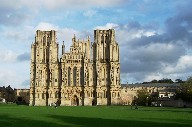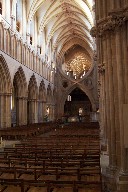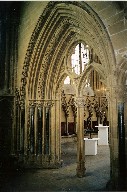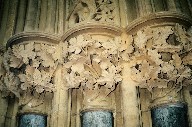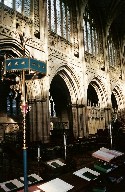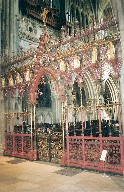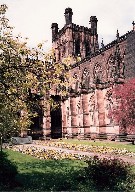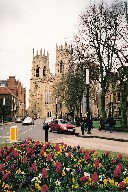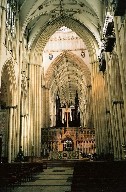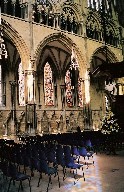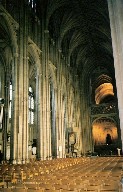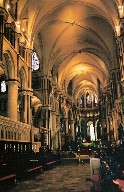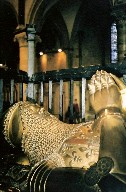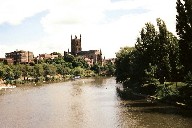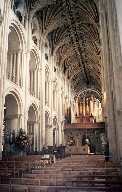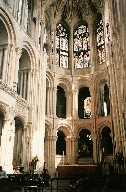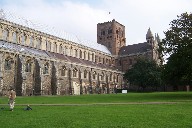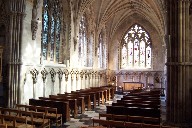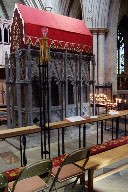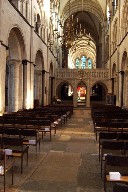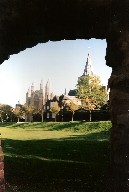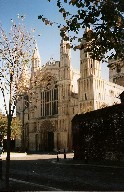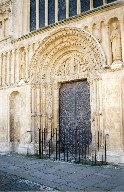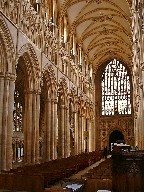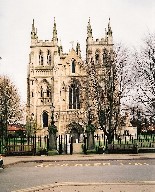  CATHEDRAL PILGRIMAGE 2001 Cathedrals are places of prayer and pilgrimage, and to sit quietly in the nave of any one imparts a sense of peace and communion with those who have sat with you for perhaps a thousand years. During the past year I have visited twelve: one for the first time, some after a gap of many years and several which I know well and to which each visit is eagerly anticipated. And there was Southwell, normally the quietest Cathedral in the country, as well as one of the loveliest. Alas, I arrived on Easter Monday afternoon, right at the end of a happy clappy pilgrimage, complete with guitars and synthesizers – all very sincere and enthusiastic I’m sure, but not for me. Luckily, next morning, all was peaceful again, and Pat and I could share the beauty of the Minster’s famous carvings with just a solitary friendly verger. My first-timer was Lichfield, set in an attractive close in a thriving little town, which remains surprisingly rural. The building is all of a piece, the three spires dominating from afar and the interior reaching a climax with the beautiful Decorated Lady Chapel, with its glorious 16th century Flemish glass. St. Chad’s Shrine stood here before the Reformation, decorated with colourful statues and adorned with precious jewels. Today a simple modern structure takes its place, much criticised in the visitors’ book, yet to me seeming wholly appropriate. Not as bad as Canterbury though, where you have to pay even to enter the close! And it’s not as if it a particularly beautiful or spacious close either, teeming as it is with visitors. Once in the cathedral you follow a prescribed route: in at the west end and out from the south transept, that’s it. Canterbury was one of those I hadn’t visited for forty years, and, frankly, I’ve no wish to go again. I know the authorities must have trouble with the sheer volume of tourists, but it seems to me that they are just cashing in. At Norwich the choir were rehearsing for a Choral Evensong broadcast later in the day, I was able to sit in the choir stalls with them and quietly enjoy the singing. In some cathedrals you aren’t allowed in the chancel, and the stalls are frequently roped off, making it impossible to look at the much vaunted misericords. The sun streaming in the great perpendicular windows makes the eastern arm of Norwich Cathedral special, and the city, with its great civic pride, is reflected in the life of the cathedral. Chichester, set amid the bustle of busy streets, is a fine Norman building, unique in having double aisles. It also has a priceless collection of modern art – a painting by Graham Sutherland, a window by Chagall, and above all, a dramatic reredos in the form of a tapestry designed by John Piper.
I must mention four other great churches which I managed to squeeze in during my journeys. The mighty Abbey at Tewkesbury, as massive as any cathedral, with a glittering array of mediaeval tombs; the exquisite Minster at Beverley, set like a Queen in the heart of East Yorkshire and full of wonderful carving; Selby Abbey, where the nave owes so much to Durham, and which must be a terrible drain on a small community; and Christchurch Priory, only fifty miles from home and possibly the least known of all these great churches. Like Norwich, the
sunlight streaming in through the great windows
in the chancel onto the mediaeval reredos and
choir stalls turns all our personal little hells
into heavens.
|
